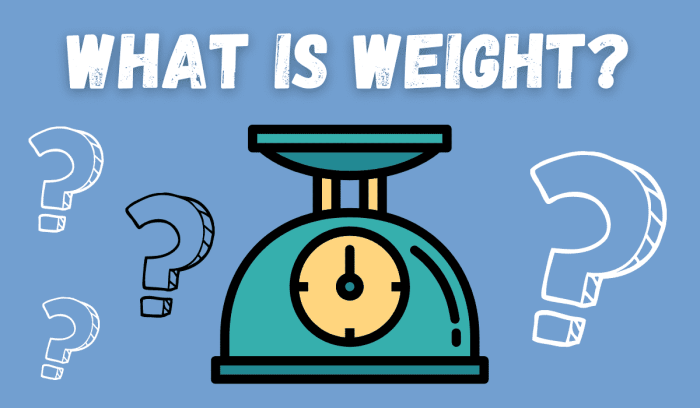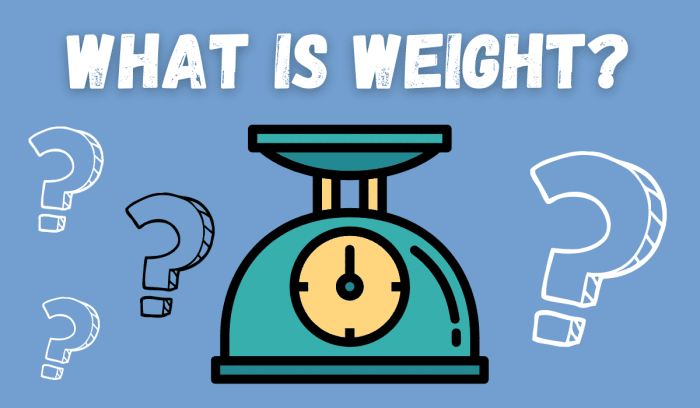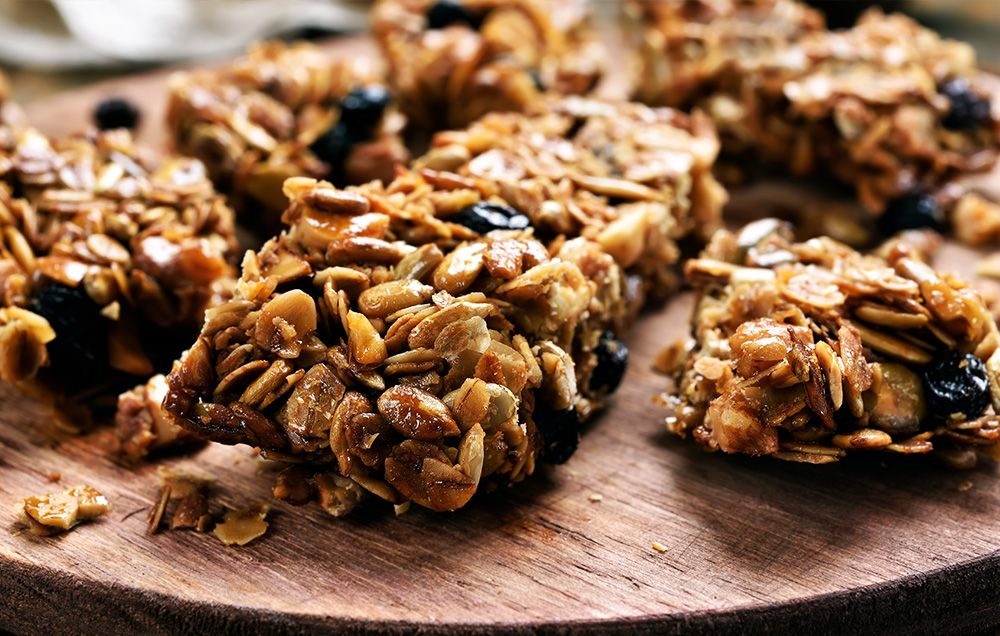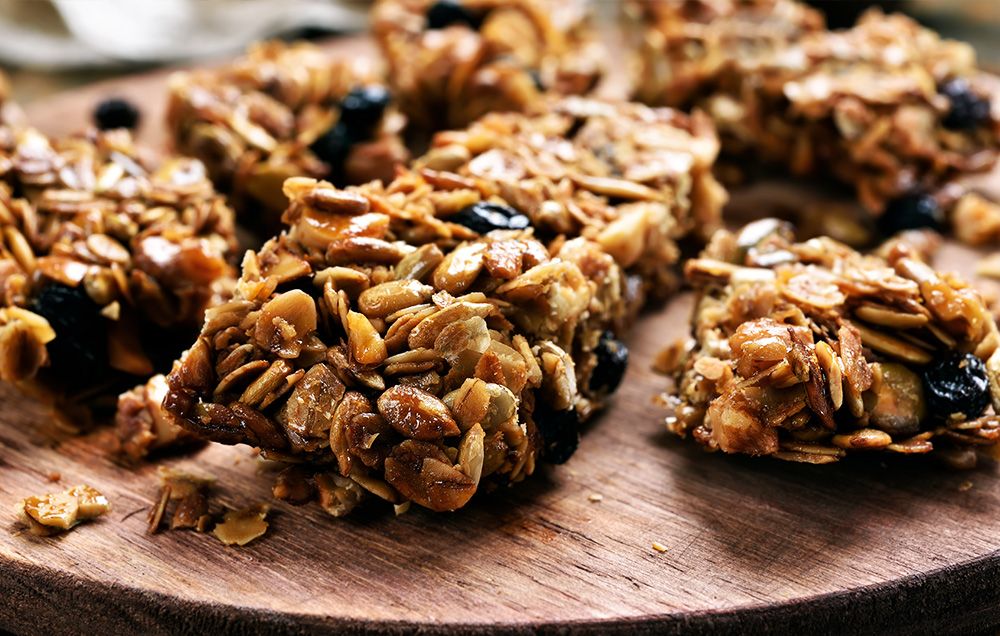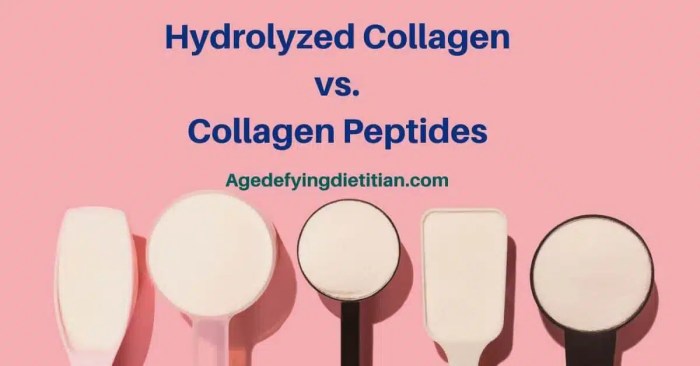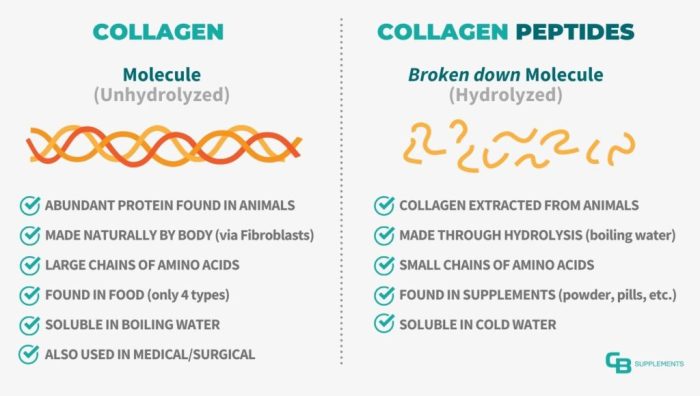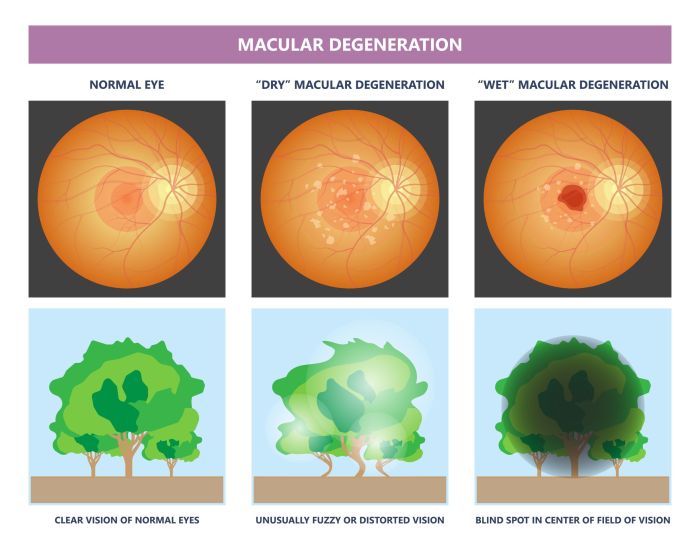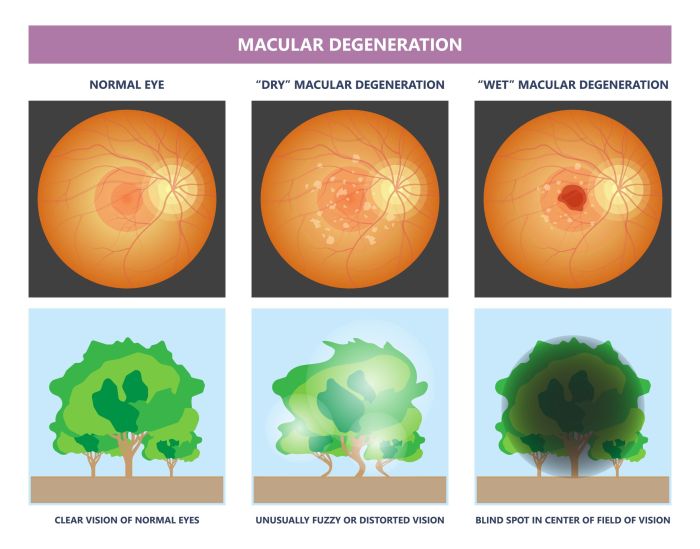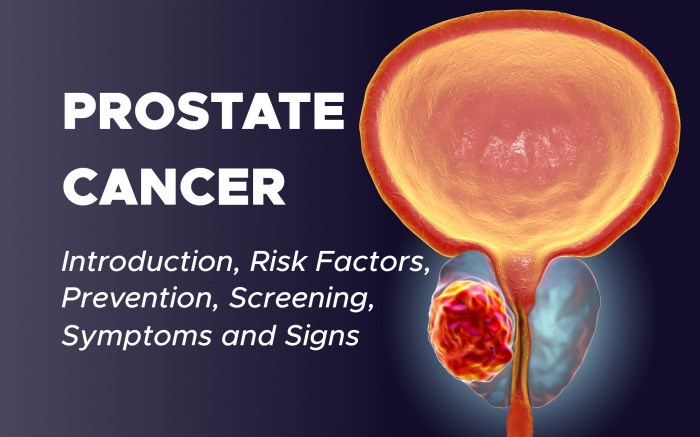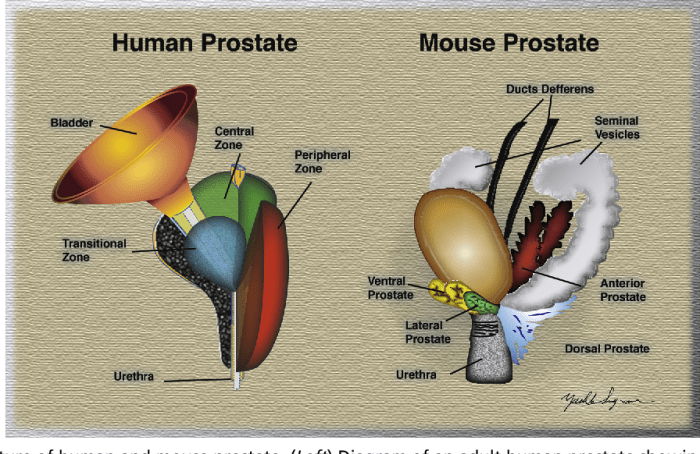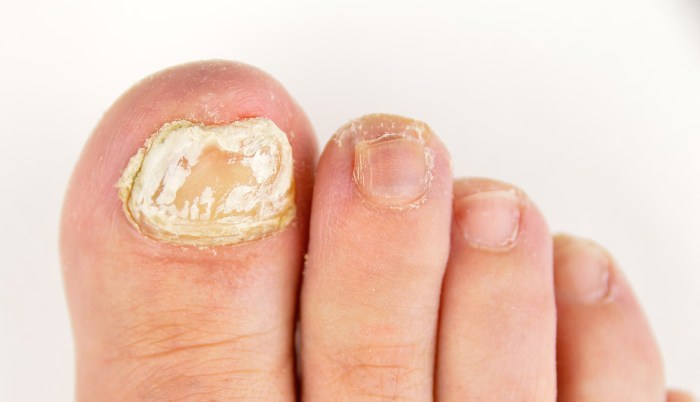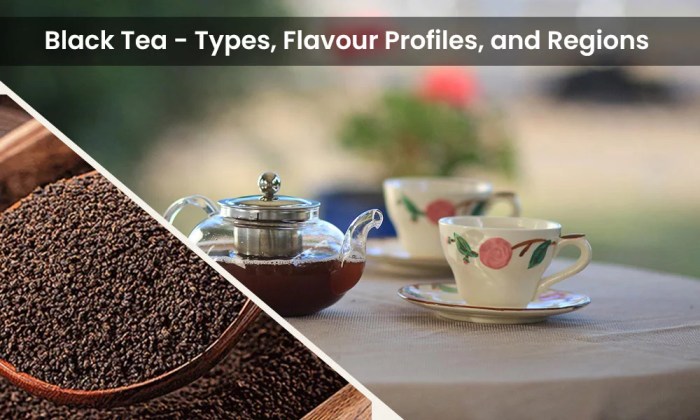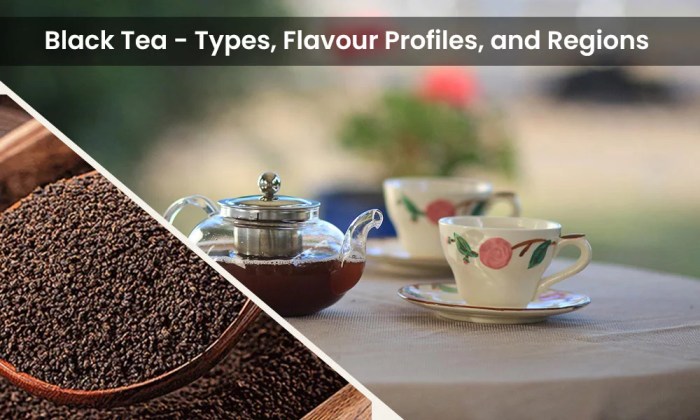Narcissistic personality disorder npd traits causes treatment – Narcissistic personality disorder (NPD) traits, causes, and treatment are explored in this comprehensive guide. Understanding the complexities of NPD, from its defining characteristics to potential causes and effective treatment strategies, is key to fostering a better understanding and support for those affected.
This in-depth look covers the diagnostic criteria, common traits, potential biological and environmental factors contributing to the development of NPD, and various treatment approaches. It also delves into the challenges faced by individuals with NPD in relationships, offering strategies for managing conflicts and setting boundaries. Cultural considerations are also addressed, recognizing the diverse ways NPD might manifest and be experienced.
Defining Narcissistic Personality Disorder (NPD)
Narcissistic Personality Disorder (NPD) is a complex mental health condition characterized by a pervasive pattern of grandiosity, a need for admiration, and a lack of empathy. Individuals with NPD often exhibit exaggerated self-importance, a preoccupation with success and power, and a tendency to exploit others to fulfill their own needs. Understanding NPD requires a nuanced approach that goes beyond simple labels and acknowledges the diverse range of experiences and challenges faced by those affected.This condition significantly impacts interpersonal relationships, professional life, and overall well-being.
It’s crucial to recognize the distinct features of NPD, distinguishing it from healthy self-esteem and other personality disorders. Diagnostic criteria provide a framework for understanding and identifying the disorder. Crucially, recognizing these patterns is not about labeling or judgment, but rather about fostering empathy and providing support for those struggling with this condition.
Understanding narcissistic personality disorder (NPD) traits, causes, and treatment options is crucial. While there’s no magic bullet, some holistic approaches show promise. For example, certain dietary supplements, like the potent combination of turmeric and apple cider vinegar, turmeric and apple cider vinegar , might potentially support overall well-being, but more research is needed to definitively link them to NPD treatment.
Ultimately, seeking professional guidance remains the most effective path for navigating the complexities of NPD.
Diagnostic Criteria for NPD
The DSM-5 (Diagnostic and Statistical Manual of Mental Disorders, 5th Edition) Artikels specific criteria for diagnosing NPD. These criteria emphasize a persistent pattern of behaviors, thoughts, and feelings that deviate significantly from societal expectations.
“A pervasive pattern of grandiosity (in fantasy or behavior), need for admiration, and lack of empathy, beginning by early adulthood and present in a variety of contexts, as indicated by five (or more) of the following: (1) has a grandiose sense of self-importance… (and so on).” – DSM-5
The DSM-5 criteria provide a structured approach for clinicians to assess and diagnose NPD. It’s important to note that not all individuals who exhibit narcissistic traits meet the full criteria for a diagnosis.
Distinguishing NPD from Normal Self-Esteem
While healthy self-esteem is crucial for well-being, narcissistic traits represent a deviation from healthy confidence. Individuals with healthy self-esteem recognize their strengths and weaknesses, and value themselves without needing external validation or admiration. In contrast, individuals with NPD rely heavily on external validation and often manipulate situations to maintain a sense of superiority.The key difference lies in the source and nature of self-worth.
Healthy self-esteem is internally generated, while narcissistic self-esteem is fragile and dependent on external validation. This difference profoundly affects relationships and emotional regulation.
Comparison with Other Personality Disorders
NPD shares some overlapping features with other personality disorders, such as histrionic personality disorder (HPD), antisocial personality disorder (ASPD), and borderline personality disorder (BPD). However, each disorder has unique characteristics and presents distinct symptoms. For instance, individuals with HPD often seek attention and are overly dramatic, while individuals with ASPD prioritize personal gain and disregard the rights of others.
BPD is characterized by intense emotional instability and a fear of abandonment.
Key Diagnostic Features of NPD
| Diagnostic Feature | Examples of Behaviors |
|---|---|
| Grandiose sense of self-importance | Exaggerating achievements, expecting special treatment, believing they are superior to others |
| Preoccupation with fantasies of success, power, brilliance, beauty, or ideal love | Constantly dreaming of unrealistic accomplishments, dwelling on idealized images of themselves |
| Belief that they are “special” and unique | Attributing extraordinary qualities to themselves, demanding admiration and special treatment |
| Requires excessive admiration | Seeking constant validation and attention from others, easily offended by perceived criticism |
| Sense of entitlement | Expecting special treatment and privileges, failing to recognize the needs and feelings of others |
| Interpersonally exploitative | Taking advantage of others to achieve personal goals, failing to reciprocate in relationships |
| Lack of empathy | Failing to recognize or understand the feelings of others, prioritizing personal needs above all else |
| Arrogant or haughty attitudes or behaviors | Showing disdain or contempt towards others, behaving in a condescending manner |
Understanding NPD Traits
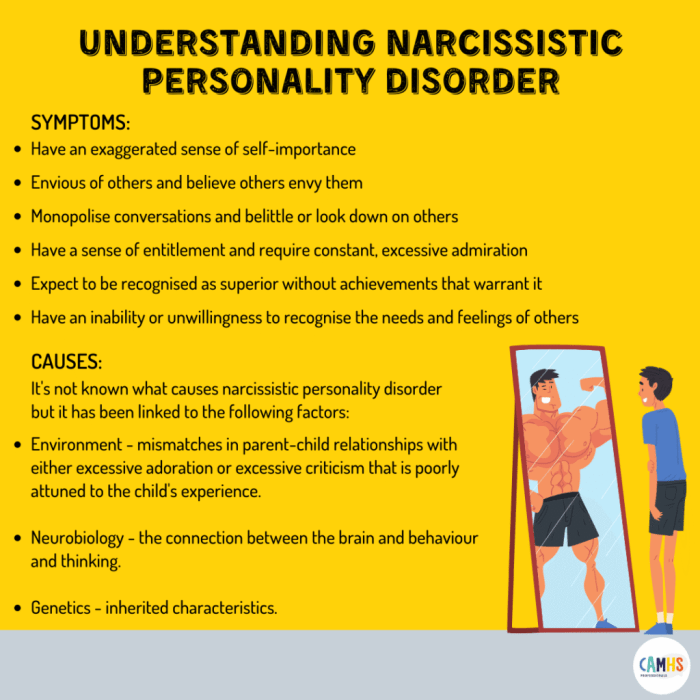
Narcissistic Personality Disorder (NPD) is characterized by a pervasive pattern of grandiosity, a need for admiration, and a lack of empathy. Understanding the specific traits associated with NPD is crucial for recognizing the disorder and supporting those affected. These traits often manifest in various ways, creating complex interpersonal dynamics and impacting daily life.Individuals with NPD often exhibit a range of behaviors that stem from their core personality traits.
Recognizing these behaviors is vital for early detection and intervention, as well as for building healthier relationships with those who have NPD.
Common Traits of NPD
Understanding the common traits associated with NPD is essential for recognizing the disorder. These traits aren’t always present in every individual, and the severity and expression of these traits can vary.
- Grandiosity: A pervasive sense of self-importance, often accompanied by fantasies of unlimited success, power, brilliance, beauty, or ideal love. This grandiosity may be overt or subtly expressed, with individuals frequently exaggerating their accomplishments or talents. For example, an individual might boast about their supposed influence on others or claim extraordinary achievements, even if they are not true. Another example might be someone who consistently speaks in exaggerated terms about themselves, their possessions, or their relationships.
- Need for Admiration: A constant craving for attention and praise, often seeking validation from others. Individuals with NPD may actively seek out opportunities to be the center of attention, or they may react intensely to perceived slights or criticisms. A classic example is someone who constantly posts self-promoting content on social media or expects excessive compliments from those around them.
- Lack of Empathy: Difficulty recognizing and understanding the feelings of others. This lack of empathy often leads to a disregard for the needs and feelings of those around them, making it difficult for them to maintain healthy relationships. An example could be someone who dismisses the concerns of a friend or family member, focusing instead on their own needs and desires.
- Exploitativeness: A tendency to take advantage of others for personal gain or gratification. This may manifest as manipulation or exploitation in various forms, from subtle attempts to control situations to outright demands. Someone who consistently takes credit for others’ work or benefits from others’ efforts without offering compensation exemplifies this trait.
Severity Spectrum and Manifestations
The severity of NPD traits can vary significantly, ranging from subtle difficulties in interpersonal relationships to severe impairments in social functioning.
Understanding narcissistic personality disorder (NPD) traits, causes, and treatment options is crucial for those affected and those around them. While exploring potential underlying factors, consider also the energizing effects of guarana, a natural stimulant found in many energy drinks. For a detailed look at guarana benefits, side effects, dosage, and storage, check out this comprehensive guide: guarana benefits side effects dosage storage.
Ultimately, seeking professional help for NPD is vital for improving well-being and relationships.
- Mild NPD: Individuals with mild NPD may exhibit some of the traits but their functioning in daily life and relationships may not be significantly impacted. They may be aware of their behaviors and strive to modify them with effort. For example, someone with mild NPD might occasionally exaggerate their accomplishments but otherwise maintain healthy relationships.
- Moderate NPD: In moderate cases, the traits are more pronounced, leading to noticeable difficulties in interpersonal relationships. The individual might struggle with maintaining healthy boundaries or have frequent conflicts with others due to their need for admiration and control. A prime example could be someone who constantly criticizes or demeans others to bolster their own perceived self-worth.
- Severe NPD: Individuals with severe NPD may have significant difficulties in all areas of life. Their traits are deeply ingrained and profoundly affect their relationships, daily functioning, and overall well-being. This often leads to isolation, strained relationships, and significant emotional distress for both the individual with NPD and those around them. An example could be someone with severe NPD who has difficulty maintaining employment or relationships due to their manipulative behaviors and lack of empathy.
Impact on Relationships and Daily Life
The table below illustrates how NPD traits can affect interpersonal interactions and social functioning.
Understanding narcissistic personality disorder (NPD) traits, causes, and treatment is crucial for those affected and those around them. Often, underlying issues like stress and emotional regulation problems can contribute to NPD, which can also manifest in physical symptoms. Maintaining a healthy lifestyle, including proper hydration, is vital for overall well-being, and this includes considering the link between high blood pressure and water intake.
High blood pressure and water intake can play a significant role in managing stress and overall health, potentially affecting NPD symptoms. Ultimately, seeking professional help for NPD is essential, combining therapies with a healthy lifestyle, like focusing on adequate hydration, for effective management.
| NPD Trait | Impact on Relationships | Impact on Daily Life |
|---|---|---|
| Grandiosity | Difficulty relating to others as equals; arrogance; expectation of special treatment | Difficulty accepting constructive criticism; entitlement; difficulty cooperating |
| Need for Admiration | Seeking constant validation and attention; controlling interactions; difficulty empathizing with others’ needs | Overly focused on self-promotion; difficulty maintaining friendships; tendency to exploit others |
| Lack of Empathy | Inability to understand or care about others’ feelings; disregard for others’ needs; manipulation | Difficulty maintaining healthy boundaries; tendency to devalue others; inability to apologize |
| Exploitativeness | Using others for personal gain; manipulation; exploitation | Difficulty reciprocating in relationships; taking advantage of others’ resources |
Causes of NPD
Understanding the causes of Narcissistic Personality Disorder (NPD) is a complex endeavor, with no single definitive answer. While a precise etiology remains elusive, a combination of biological predispositions and environmental influences likely plays a crucial role in its development. This exploration delves into potential contributing factors, ranging from genetic predispositions to early childhood experiences and various theoretical perspectives.
Biological Factors
Certain biological factors may increase a person’s vulnerability to developing NPD. Research suggests a possible genetic component, implying that individuals with a family history of personality disorders, particularly those exhibiting narcissistic traits, might be at a higher risk. Neurobiological factors, such as imbalances in neurotransmitter systems or structural differences in the brain, are also considered possible contributors. However, more research is needed to fully understand the precise biological mechanisms involved.
Environmental Factors
Early childhood experiences are believed to play a significant role in the development of NPD. A lack of empathy or mirroring from caregivers, inconsistent or neglectful parenting, or overly critical or indulgent environments are all potential contributing factors. Furthermore, significant trauma or adverse experiences in childhood could potentially shape the development of narcissistic tendencies. It’s crucial to note that these factors are not deterministic; not every individual experiencing these circumstances will develop NPD.
Theoretical Perspectives
Various theoretical frameworks attempt to explain the development of NPD. Psychodynamic theories, for example, often emphasize early childhood relationships and the impact of unmet emotional needs. Cognitive theories, conversely, highlight the role of distorted thinking patterns and self-schemas in shaping narcissistic behaviors. Attachment theory also offers a perspective, emphasizing the importance of early attachment relationships in shaping an individual’s capacity for healthy relationships and self-perception.
These diverse theoretical viewpoints contribute to a more comprehensive understanding of NPD’s complexity.
Potential Contributing Factors and Supporting Evidence
| Potential Cause | Supporting Evidence |
|---|---|
| Genetic predisposition | Family history studies show a higher prevalence of NPD in individuals with a family history of personality disorders. Twin studies offer further insight into the potential genetic contribution. |
| Early childhood experiences (e.g., inconsistent parenting, emotional neglect) | Case studies and observational research suggest that a lack of empathy, emotional mirroring, or consistent parental attention during formative years might be linked to the development of narcissistic traits. |
| Neurobiological factors (e.g., imbalances in neurotransmitter systems) | Emerging research in neuroscience explores potential correlations between specific neurotransmitter levels and narcissistic behaviors, but more conclusive evidence is needed. |
| Cognitive distortions (e.g., grandiosity, entitlement) | Cognitive behavioral therapy (CBT) studies suggest that individuals with NPD exhibit specific cognitive patterns that contribute to their behaviors. |
| Attachment theory | Attachment theory proposes that early attachment experiences significantly influence the development of self-perception and interpersonal relationships, potentially impacting the development of narcissistic traits. |
Interrelationships of Contributing Factors
Understanding NPD’s etiology involves recognizing the complex interplay of various factors. Genetic predisposition may make an individual more susceptible to developing NPD, but environmental factors can either exacerbate or mitigate this vulnerability. For example, a child with a genetic predisposition for certain personality traits might exhibit these traits more intensely if raised in an environment that reinforces or validates these traits.
Similarly, childhood experiences can shape cognitive distortions and self-schemas, which in turn may interact with neurobiological factors to influence the development of narcissistic behaviors.
Treatment Approaches for NPD
Treating narcissistic personality disorder (NPD) is a complex and often challenging process. Success hinges on the individual’s willingness to engage in therapy and address underlying issues. While a complete cure isn’t typically achievable, effective treatment can lead to significant improvements in managing symptoms and relationships.Addressing the multifaceted nature of NPD requires a tailored approach that acknowledges the individual’s unique needs and challenges.
The primary goal of treatment is to help individuals recognize and modify maladaptive patterns of thinking and behavior, fostering healthier interpersonal relationships and a more realistic self-perception.
Common Psychological Therapies for NPD
Various psychological therapies are employed in treating NPD. These approaches aim to help individuals develop insight into their patterns of behavior, understand the roots of their narcissistic traits, and develop healthier coping mechanisms. Crucially, the therapies often involve a strong emphasis on building empathy and understanding of others’ perspectives.
- Cognitive-Behavioral Therapy (CBT): CBT is a widely used approach that focuses on identifying and modifying negative thought patterns and behaviors. For individuals with NPD, CBT helps to challenge the grandiose self-image and unrealistic expectations that often characterize the disorder. By identifying and modifying distorted thought processes, CBT can facilitate the development of more realistic self-perceptions and improved interpersonal interactions.
For instance, a CBT therapist might help a client with NPD challenge the belief that they are inherently superior to others and encourage them to view themselves in a more balanced light.
- Psychodynamic Therapy: Psychodynamic therapy delves into the unconscious motivations and past experiences that might contribute to the development of NPD. This approach aims to uncover the underlying emotional conflicts and relational patterns that may have shaped the individual’s personality and their narcissistic traits. Through exploring past experiences and analyzing current relational patterns, psychodynamic therapy can help individuals gain greater self-awareness and understand the origins of their difficulties.
A psychodynamic therapist might explore early childhood experiences or problematic relationship patterns to uncover underlying issues that contribute to the narcissistic traits.
- Schema Therapy: This approach, building on CBT and psychodynamic principles, focuses on identifying and modifying maladaptive schemas, or deeply ingrained patterns of thinking and behaving. In the context of NPD, schema therapy helps uncover core beliefs and assumptions that contribute to narcissistic traits, such as a need for admiration and a fear of abandonment. By challenging these underlying schemas, individuals can develop more adaptive ways of relating to others and responding to emotional challenges.
This is particularly useful in helping individuals with NPD to address their core vulnerabilities and learn to manage emotions in healthier ways.
Cognitive-Behavioral Therapy (CBT) for NPD Traits
CBT aims to help individuals with NPD challenge and modify maladaptive thought patterns that fuel their behaviors. Through specific techniques, such as cognitive restructuring, clients learn to identify and reframe negative or distorted thoughts about themselves and others. This approach helps in developing a more balanced and realistic self-perception. This involves exploring the origins of these distorted thoughts and replacing them with more accurate and helpful perspectives.
Psychodynamic Therapy’s Role in Understanding and Treating NPD
Psychodynamic therapy, through exploring unconscious motivations and past experiences, provides insights into the roots of narcissistic patterns. By examining early childhood relationships and relational patterns, psychodynamic therapy can help individuals understand how past experiences might have shaped their current behaviors. This can involve exploring the interplay between early childhood experiences, interpersonal relationships, and the development of NPD traits.
Treatment Strategies and Potential Effectiveness
Treatment effectiveness varies greatly depending on the individual’s motivation, commitment, and the nature of their narcissistic traits. The treatment strategy should be tailored to the specific needs of the individual. Often, a combination of therapies may be most beneficial.
| Treatment Approach | Strengths | Weaknesses |
|---|---|---|
| Cognitive-Behavioral Therapy (CBT) | Structured, focused on present behaviors, provides practical tools for change. | May not address underlying unconscious motivations, potentially less effective for severe NPD. |
| Psychodynamic Therapy | Provides deeper understanding of unconscious motivations, explores early experiences. | Can be lengthy and demanding, requires significant commitment from the client. |
| Schema Therapy | Combines CBT and psychodynamic principles, addresses underlying schemas and vulnerabilities. | Requires significant therapist training, potentially more complex than CBT alone. |
Living with NPD: Narcissistic Personality Disorder Npd Traits Causes Treatment
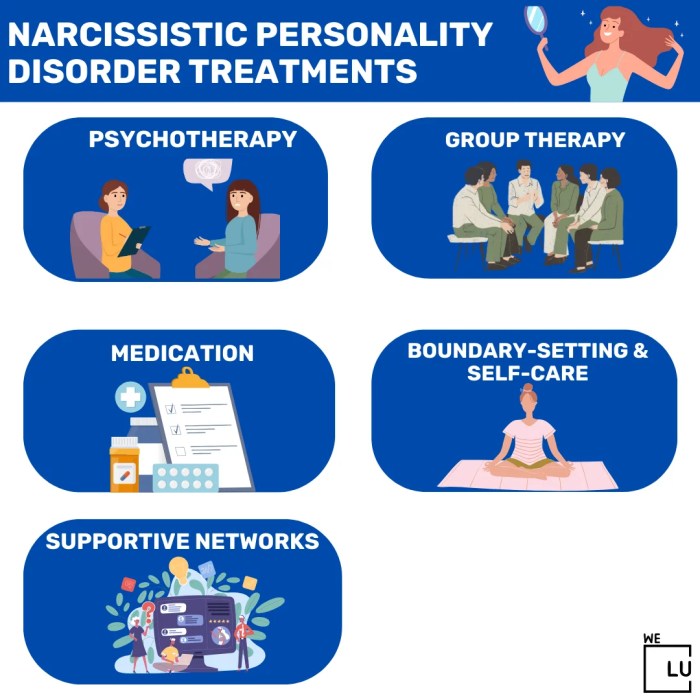
Navigating a relationship with someone exhibiting narcissistic personality disorder (NPD) traits can be incredibly challenging. Understanding the specific dynamics and patterns of behavior associated with NPD is crucial for those involved. This understanding provides a framework for effective communication, conflict resolution, and setting healthy boundaries. The following sections will explore the complexities of living with NPD and offer strategies for navigating these challenges.
Challenges in Relationships with NPD
Individuals with NPD often struggle to maintain healthy relationships. Their need for admiration, their tendency to exploit others, and their inability to empathize can strain connections. Common relationship issues include manipulation, emotional detachment, and a lack of accountability. This can lead to significant distress for those involved, creating a feeling of being caught in a cycle of emotional turmoil.
A crucial aspect of understanding this dynamic is recognizing that these behaviors aren’t deliberate attempts to harm but rather manifestations of the underlying personality disorder.
Managing Interpersonal Conflicts
Effective conflict resolution with NPD individuals requires a unique approach. Direct confrontation often escalates the situation. Instead, focusing on specific behaviors and their impact, rather than personal attacks, is more likely to be productive. Clear and concise communication, avoiding emotional language, and presenting facts are key strategies. Setting clear boundaries and maintaining personal space are essential for managing conflict.
Understanding the underlying needs and motivations behind the behavior, though challenging, can facilitate a more productive conversation.
Coping Mechanisms for Those in Relationships
Developing coping mechanisms is vital for individuals in relationships with NPD. Recognizing the pattern of behaviors and their impact on well-being is crucial. Seeking support from therapists, support groups, or friends can provide emotional validation and practical strategies. Practicing self-care, including mindfulness, relaxation techniques, and engaging in activities that bring joy, is essential for maintaining emotional balance.
Limiting exposure to the individual’s manipulative tactics and setting clear boundaries are important steps.
Setting Boundaries with NPD Individuals, Narcissistic personality disorder npd traits causes treatment
Setting boundaries with individuals exhibiting NPD traits is crucial for maintaining one’s own well-being. These boundaries must be clearly communicated, consistently enforced, and well-defined. Boundaries should address specific behaviors, not the individual as a person. This approach prevents the individual from feeling attacked or invalidated. Emphasizing the impact of their actions on others is important for fostering understanding, though it’s crucial to understand that this approach might not always result in a change in behavior.
Communicating Effectively
| Communication Style | Description | Example |
|---|---|---|
| Direct and Specific | Focus on observable behaviors and their impact. | “When you interrupt me, it makes me feel disrespected.” |
| Clear and Concise | Avoid ambiguity and emotional language. | “I need space right now.” |
| Fact-Based | Present objective information and avoid interpretations. | “You missed the meeting three times last week.” |
| Respectful Tone | Maintain a calm and respectful demeanor. | “I’m concerned about this.” |
| Active Listening | Pay attention to what the other person is saying, acknowledge their points. | “I hear you saying…” |
| Assertive Language | Express your needs and feelings directly. | “I need you to be more respectful.” |
| Avoiding Emotional Reacting | Remain calm and avoid getting drawn into arguments. | “I understand you’re upset, but I need to focus on…” |
Clear communication strategies are vital for fostering healthy interactions and maintaining personal boundaries. Understanding the nuances of communication with individuals exhibiting NPD traits is essential for effective interactions. This table provides a framework for respectful and constructive communication.
Illustrative Case Studies
Understanding Narcissistic Personality Disorder (NPD) requires more than just definitions and diagnostic criteria. Examining real-life examples illuminates the complexities of this condition and the challenges faced by individuals and those around them. Case studies provide a window into the lived experience, offering insight into the specific behaviors, interpersonal dynamics, and treatment considerations associated with NPD.A crucial aspect of these studies is the exploration of how NPD impacts relationships.
Individuals with NPD often struggle to maintain healthy, reciprocal connections. Their need for admiration and validation can lead to exploitative behaviors, causing significant distress and damage to those in their social circles. These case studies will demonstrate the profound impact of NPD on both the individual and their environment.
Hypothetical Case Study: Ethan
Ethan, a 35-year-old marketing executive, embodies several key traits of NPD. He consistently seeks admiration and validation, often exaggerating his accomplishments and talents. He displays a deep-seated sense of entitlement, believing he deserves special treatment and preferential consideration. Ethan often dismisses the contributions of others, viewing them as inferior or irrelevant to his own success.
Specific NPD Traits and Behaviors
Ethan exhibits a pattern of arrogant and haughty behaviors. He frequently criticizes others, particularly those he perceives as threats to his perceived superiority. His relationships are characterized by a lack of empathy and a focus on his own needs and desires. He struggles to maintain healthy boundaries, often exploiting others to further his own goals. He has a fragile sense of self-esteem, constantly seeking external validation.
His self-image is contingent on the approval of others.
Challenges Faced by Ethan
Ethan’s challenges are multifaceted. His grandiose sense of self-importance leads to interpersonal conflicts. His inability to empathize with others isolates him from genuine connections. He frequently experiences intense feelings of shame or anger when faced with criticism or perceived slights. This cycle of self-validation and external validation creates a vicious loop, preventing him from developing healthier coping mechanisms.
His relationships are strained due to his demands and exploitative tendencies. He struggles to maintain friendships and romantic partnerships, as his need for control and admiration often clashes with the needs of others.
Treatment Approaches for Ethan
Several therapeutic approaches could be beneficial for Ethan. Cognitive Behavioral Therapy (CBT) could help him identify and challenge his distorted thinking patterns, such as his inflated sense of self-importance and entitlement. Psychodynamic therapy could explore the underlying emotional and relational dynamics that contribute to his narcissistic tendencies. Group therapy could provide a supportive environment for him to practice empathy and develop healthier social skills.
The goal of treatment would be to help Ethan develop a more realistic self-image, fostering self-awareness and reducing the reliance on external validation.
Impact on Relationships and Well-being
Ethan’s NPD significantly impacts his relationships and well-being. His exploitative behavior and lack of empathy damage his personal and professional relationships. He often experiences feelings of emptiness and dissatisfaction, despite achieving external success. His inability to form genuine connections leaves him isolated and lonely, despite his apparent social status. Treatment aims to help him understand the root causes of his behaviors and develop healthier ways of interacting with the world.
Cultural Considerations
Cultural factors play a significant role in shaping the expression and perception of narcissistic personality disorder (NPD). Different societies hold varying values and expectations regarding self-esteem, achievement, and interpersonal relationships. These differences can influence how individuals display narcissistic traits and how others interpret those behaviors. Understanding these cultural nuances is crucial for accurate diagnosis and effective treatment.
Cultural Influences on NPD Expression
Cultural norms significantly impact the way NPD traits manifest. In some cultures, assertiveness and ambition are highly valued, which could lead to behaviors that are perceived as narcissistic by those from different cultural backgrounds. Conversely, cultures that prioritize humility and deference might interpret behaviors that are considered assertive in other contexts as signs of NPD. This highlights the need for cultural sensitivity in evaluating and understanding the nuances of individual behaviors.
Cultural differences in family structures, social hierarchies, and communication styles can also contribute to varied expressions of NPD.
Cultural Norms and Perceptions of NPD
Cultural norms significantly shape perceptions of NPD. In collectivist cultures, where group harmony and interdependence are emphasized, individuals exhibiting traits associated with NPD, such as self-promotion and disregard for others, might be viewed negatively and judged more harshly than in individualistic cultures where self-reliance and achievement are celebrated. These differing societal expectations directly influence how NPD is perceived and diagnosed.
The interpretation of behaviors like grandiosity and entitlement is highly contingent on cultural context.
Cultural Perspectives on NPD
Different cultures hold diverse perspectives on NPD. In some cultures, grandiosity and self-importance might be seen as desirable traits, particularly in leadership roles. This highlights the need to consider cultural context when assessing individuals for NPD. In some East Asian cultures, for instance, humility and deference are valued, so behaviors that might be considered narcissistic in other contexts might be viewed as culturally appropriate.
Furthermore, the concept of self-esteem and its importance in individual development varies greatly across cultures.
Impact of Cultural Differences on Treatment Approaches
Cultural differences significantly impact treatment approaches for NPD. Therapy approaches that are effective in one culture might not be suitable in another. For example, therapies emphasizing individualistic self-exploration might be less effective in cultures where group harmony and family relationships are prioritized. Cultural sensitivity is paramount when selecting treatment strategies. The treatment plan should take into account the individual’s cultural background and beliefs.
Table: Cultural Factors Affecting NPD Diagnosis and Treatment
| Cultural Factor | Impact on Diagnosis | Impact on Treatment |
|---|---|---|
| Emphasis on Collectivism vs. Individualism | May lead to misinterpretations of behaviors as narcissistic in collectivist cultures where self-promotion is discouraged, or as less narcissistic in individualistic cultures where it is more accepted. | Individualistic therapies might be less effective in collectivist cultures, while group therapies emphasizing interpersonal relationships might be more beneficial. |
| Social Hierarchies and Power Dynamics | Behaviors that are perceived as narcissistic in one culture might be considered appropriate in another if they are part of a power structure. | Therapies need to acknowledge and address power imbalances within the cultural context. |
| Communication Styles | Direct and assertive communication styles might be misinterpreted as narcissistic in some cultures, whereas indirect communication might be perceived as passive or unassertive in others. | Therapists need to be aware of communication styles to build trust and rapport with the client. |
| Religious and Spiritual Beliefs | Beliefs about self-worth, humility, and the role of the individual might influence the expression and interpretation of NPD traits. | Treatment should incorporate the individual’s spiritual beliefs and values to foster a sense of meaning and connection. |
Ending Remarks
In conclusion, narcissistic personality disorder (NPD) is a complex condition with diverse contributing factors. This discussion has highlighted the importance of understanding the traits, causes, and various treatment options available. While challenges in relationships and daily life are significant, effective strategies and support systems can help individuals and those close to them navigate these complexities. A nuanced understanding, informed by diverse perspectives, is crucial for supporting individuals with NPD and promoting their well-being.

